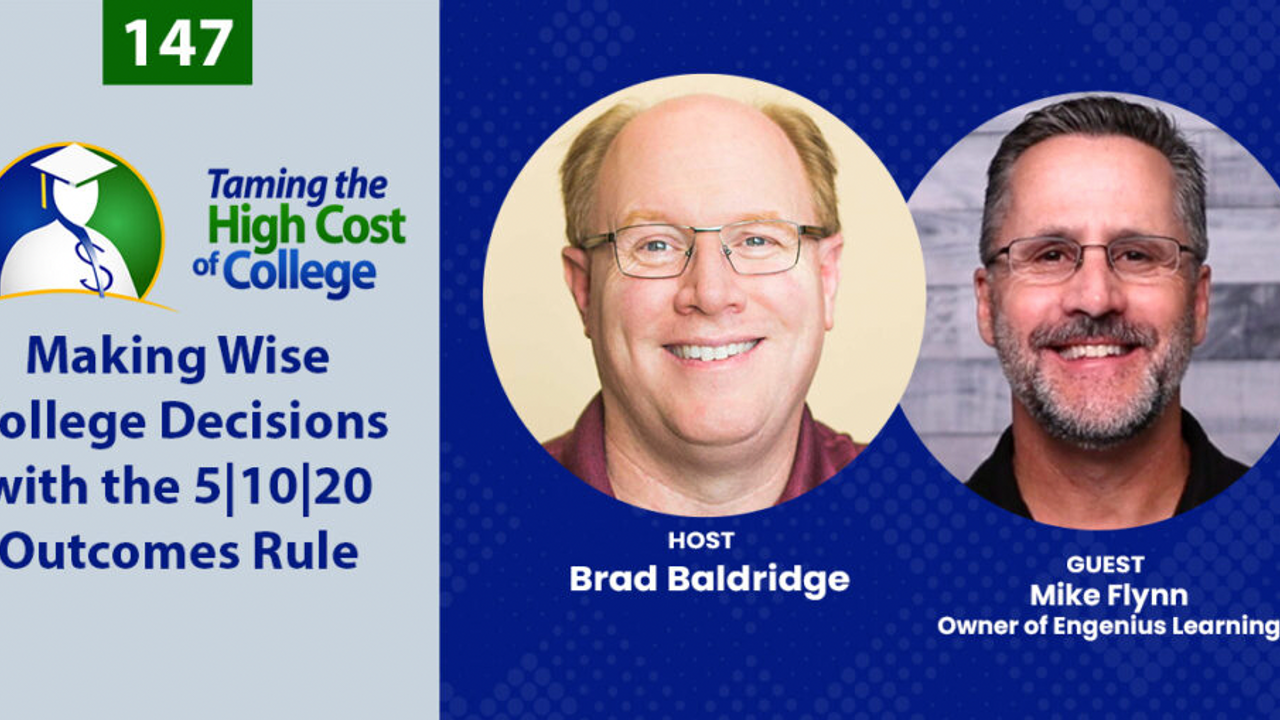Making Wise College Decisions by Using Data to Influence, Not Drive Your Decision

How to Use Data to Select the Perfect College
I was the guest on episode 147 of Taming the High Cost of College Podcast with Brad Baldridge.
We talked about using data to help influence college selections and a number of other college prep questions.
Below is a link to the podcast as well as the questions answered during the interview.
Questions Answered:
When should I start thinking of preparing my student for college?
Mike thinks that early planning is the way to go if parents want to make sure that their students are college-ready. As early as middle school, parents should already be taking baby steps towards college planning. These steps include:
- Equipping yourself with good information about being successful in college
- Helping your student succeed through middle school and high school
- Preparing financially
- Talking to your student about college.
In particular, Mike believes that preparing students for college starts as early as middle school, with emphasis on how middle school success is a better indicator of success in college rather than high school GPA and SAT/ACT scores.
Mike mentions the following program and resources to help explain why success in middle school matters:
- The Knowledge is Power Program – a program that equips students to get into college, starting with helpful insights and guidance they can use as early as in the fifth grade. The program has an 85% success rate of getting kids (including low socioeconomic kids) into college.
- The Forgotten Middle – a report produced by ACT that indicates how critical it is for students to reach college readiness in middle school.
Many colleges have become test-optional. Should I submit my student’s ACT or SAT test scores or not?
Because of the pandemic, the lack of available testing centers pushed many colleges to go test-optional and test-blind. Here’s what these two terms mean:
- Test-optional means that it’s the student’s option to submit their test scores or not
- Test-blind means that students don’t have to submit their test scores at all, since these colleges don’t require or consider scores at all.
Mike says it might be a good idea to submit your scores if your scores are near the 75th percentile of the college you’re applying to. Scores at that level may be helpful for your application. If you’re not in the 75th percentile, then don’t submit your scores.
Keep in mind though: good SAT or ACT scores won’t compensate for bad grades and poor academic rigor.
Many schools have become test-blind. Should my student bother taking the SAT and ACT at all?
Absolutely! These tests are good indicators of the students:
- Critical reading
- Grammar
- Mathematical reasoning.
How does this help? Each college posts the average scores of accepted applicants on its website, and if your score is near the average, then that school may be a good fit. Mike thinks that ACT and SAT scores are a strong form of diagnostics to really tell if a student will thrive in a certain college or not. Take a look at this scenario:
Student A has a very impressive profile with a 4.2 GPA, lots of AP and honors courses, and a 1250 SAT score. Student A wants to go to Stanford, which is test-optional, but accepted applicants generally have an average SAT score of 1540, which is extremely competitive. Student A can apply to Stanford and may get accepted, but is it the right school? It may not be. Student A may be extremely smart and equally diligent, but might just be different from the type of students that thrive at Stanford.
Also, Mike believes that test scores won’t be gone for good because they’re data points that colleges (and especially the top ones) use to look at how high schools perform. The test scores and academic standards of your high school are a deciding factor for colleges when they’re deciding whether or not to accept a student. If test scores go away, then it will be even harder for students in lesser-known high schools to get accepted.
Here’s another example that shows how important testing is, despite many schools going test-optional:
A student takes eight hours to complete a four-hour test and gets a perfect score. This means that the student’s problem is not content, but pacing. Therefore, it may not be a good idea to go to MIT or CalTech, where 99% of the kids have 99th percentile scores. If you’re slower to get academic work done or perform on tests, then it may be hard to keep up.
Mike’s final advice is to assume that these tests are important. Taking tests won’t be a loss, even if the scores are unused for admissions. One way or another, tests help students determine their strengths and weaknesses, which can help greatly in the college selection process.
If college is not the parent’s decision to make, then what’s my role as a parent?
Choosing a college is indeed your child’s decision to make, but it doesn’t mean that parents shouldn’t care. It’s best to let your student decide according to their best interests. Parents can help by:
- Doing early research about the college planning process
- Asking for help from college planning experts (which most parents don’t know exist)
- Helping your student build a ‘lifelong network’
- Ensuring your student is on the right path to college (i.e. getting good grades).
The most important role for parents is to make wise college financial decisions, which means:
- Balancing what your student wants and the family’s financial capability
- Focusing on the best overall option rather than the lowest-cost option.
For Mike, choosing a college should be similar to choosing a house or a car to buy. It’s always a balance between the family’s financial capability as well as what will be the best for the family.
What is the 5|10|20 outcomes rule in college decisions?
After years of experience and after seeing a pattern among students failing to survive in top schools that Mike helped them get into, Mike realized that getting into the best schools (i.e. Ivy League) should not be the goal. It should be a balance of many aspects. Hence, Mike created the 5|10|20 outcomes rule.
Here’s what the rule asks you to consider:
- “Is there at least a 70% chance that I will get my degree in 5 years?”
- “Look for colleges where the 5-year graduation rate is 70% or better. Anything less than the national average of 63.8% should be concerning.” – Mike Flynn
- Check out this data set for reference on graduation rate
- “Will I get a positive Return on Investment (ROI) on my degree within 10 years?
- In business, ROI is an indicator if an investment has made a profit or a deficit. This concept is equally useful in college planning because there are colleges and degrees that project higher ROI than others in a span of 10 years. Learn more about computing ROIs here.
- Based on Mike’s College Expense or Investment Calculator, you should find colleges and degrees that will help you gain a positive ROI (at least 33) within 10 years or earlier. (Please note: the national average is 44).
- Mike’s data is a good indicator if the cost of college and degree you’re choosing is a good gamble.
- “What’s my outlook for 20 years?”
- Choose a college and major that will be an investment rather than an expense in 20 years, which essentially means that you need to get a job that has the least risk of being phased out in the years to come.
Mike has the 5|10|20 outcomes rule database available for parents who need help with decision-making. This resource features a list of colleges and their corresponding 5|10|20 outcomes.
Is this rule going to be the complete basis for making decisions?
No, but it will help parents see if college will be an investment or simply an expense.
Relevant Links
Stay connected with news and updates!
Join our mailing list to receive the latest news and updates from our team.
Don't worry, your information will not be shared.
We hate SPAM. We will never sell your information, for any reason.

